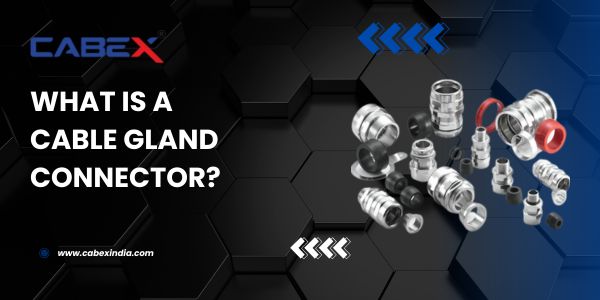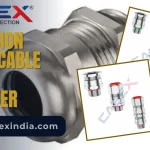In the intricate world of electrical and electronic systems, the seamless transmission of power and data is a paramount concern. One of the unsung heroes ensuring this flawless connectivity is the Cable Gland Connector. Despite its unassuming appearance, this small yet essential component plays a pivotal role in maintaining the integrity of cables, safeguarding equipment, and ultimately contributing to the efficiency and safety of various industries.
Understanding Cable Gland Connectors
A Cable Gland Connector, often simply referred to as a cable glands, is a mechanical device used to secure and seal cables entering or exiting an enclosure or piece of equipment. Its primary function is to provide strain relief, prevent cable pullout, and offer protection against environmental factors such as dust, moisture, and even chemical exposure. These connectors are designed to maintain the ingress protection (IP) rating of an enclosure, ensuring that it remains resilient against external elements.
Design and Components
Cable gland connectors are ingeniously designed to accommodate a wide range of cable sizes and types. They consist of several key components that collectively ensure a secure and efficient cable management system.
1. Body:
The body of a cable gland connector forms the central structure. It is typically threaded and serves as the primary means of attachment to an enclosure or equipment. The threading allows for a secure fit, preventing the connector from accidentally loosening due to vibrations or external forces.
2. Gland Nut:
The gland nut is threaded onto the body of the connector and is responsible for clamping the cable in place. As the nut is tightened, it compresses the various components of the gland to secure the cable firmly while also creating a reliable seal against environmental elements.
3. Sealing Components:
Cable gland connectors feature multiple layers of sealing components to ensure a robust seal. These components often include an O-ring, grommet, or washer, each playing a crucial role in preventing the ingress of dust, water, or other contaminants. The choice of sealing material depends on the application’s specific requirements, including temperature, chemical exposure, and IP rating.
4. Clamping Mechanism:
To prevent strain on the cable itself, cable gland connectors incorporate a clamping mechanism. This mechanism evenly distributes the pulling force along the length of the cable, minimizing the risk of damage and maintaining the cable’s integrity.
5. Cable Attachment:
The actual attachment of the cable to the connector can vary. Some cable glands have a design that allows cables to be simply pushed through, while others require cable ends to be stripped and properly terminated. This diversity in attachment methods caters to the diverse range of cables used across industries.
Applications Across Industries
Cable gland connectors find their utility across an array of industries due to their versatile design and protective capabilities. Some notable sectors where these connectors play an indispensable role include:
1. Electrical Industry:
In the electrical sector, cable gland connectors are a staple for connecting power cables to distribution panels, junction boxes, and electrical enclosures. They ensure a secure connection while minimizing the risk of short circuits or power interruptions due to cable movement.
2. Oil and Gas:
In the demanding environments of the oil and gas industry, cable gland connectors provide vital protection against harsh elements. They are employed to safeguard cables in offshore rigs, refineries, and pipelines, where exposure to corrosive substances and extreme weather conditions is a constant challenge.
3. Manufacturing:
The manufacturing industry relies heavily on automated processes and machinery, often operating in dusty or wet environments. Cable gland connectors are crucial here to prevent water and dust ingress into sensitive machinery, thus preventing downtime and maintaining production efficiency.
4. Data Centers:
Data centers are the nerve centers of modern technology, housing servers and networking equipment. Cable gland connectors ensure seamless connectivity by safeguarding the intricate network of cables from external contaminants that could disrupt data transmission and compromise server integrity.
5. Pharmaceuticals:
Pharmaceutical manufacturing demands a sterile environment, making cable gland connectors invaluable for ensuring that cables passing through clean rooms or controlled environments do not introduce contaminants that could compromise the quality of pharmaceutical products.
Choosing the Right Cable Gland Connector
Selecting the appropriate cable gland connector for a specific application involves careful consideration of various factors. These factors include:
1. Cable Type and Size:
Different cables have different diameters and sheathing materials. Choosing a cable gland connector that matches the cable’s specifications ensures a snug fit and optimal protection.
2. Environmental Conditions:
The operating environment plays a critical role in determining the type of cable gland connector required. Factors such as temperature, moisture level, exposure to chemicals, and potential physical stress are all important considerations.
3. Ingress Protection Rating:
Cable gland connectors are assigned an IP rating that indicates their level of protection against solids and liquids. Understanding the required IP rating for the specific application is essential to ensure adequate protection.
4. Cable Termination Method:
The method by which the cable is terminated within the connector can vary. Some connectors accommodate pre-terminated cables, while others require on-site cable termination. The chosen method should align with the project’s requirements and installation capabilities.
Installation Process
Proper installation of cable gland connectors is crucial to ensure their effectiveness. The installation process generally involves the following steps:
- Preparation: Measure the cable diameter and select an appropriate cable gland connector.
- Drilling: If not already present, create a hole in the enclosure or equipment for the cable entry point.
- Insertion: Thread the cable through the cable gland connector and insert it into the drilled hole.
- Sealing: Assemble the sealing components onto the connector. These may include O-rings, washers, or grommets.
- Clamping: Tighten the gland nut to secure the cable in place and evenly distribute clamping force.
- Testing: Verify the effectiveness of the seal and ensure the cable is securely fastened.
Conclusion
The unassuming cable gland connector, often overshadowed by more prominent components, is undeniably a linchpin in the world of cable management and system integrity. Its ability to secure, protect, and maintain the reliability of cables across diverse industries is a testament to its importance. As technology continues to advance and industries evolve, the unyielding role of cable gland connectors in ensuring seamless connectivity and safeguarding critical systems remains unwavering.
For Buying cable gland connector at best price, then
Click Here
FAQ:
What is the difference between cable gland and cable connector?
A cable gland secures and seals cables entering enclosures, offering environmental protection. A cable connector joins cables, facilitating electrical or data connections. Both serve distinct roles in cable management.
What are the 3 types of cable connectors?
The three primary types of cable connectors are coaxial connectors, fiber-optic connectors, and twisted-pair connectors. Each serves distinct communication needs and interfaces within various industries and applications.
Which gland is armoured cable?
Armoured cables typically use “SWA” (Steel Wire Armoured) cable glands for secure and effective cable management, providing strain relief and environmental protection.










